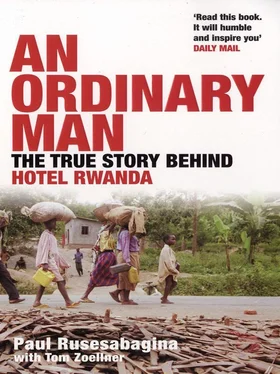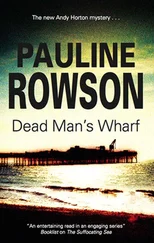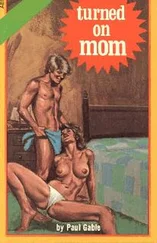I can’t begin to tell you how revolutionary this was. Unlike the dull government marginalia you usually heard on the official Radio Rwanda, RTLM was fresh. It was irreverent. It was fun. It constantly surprised you. It was giving us what we wanted but in a way that was lively and modern and American. Even those who were offended were hooked. It was the giddiness that comes with looking at your friend in shock and saying, Can he really say that? Yes, I think he just did.
Just as Rwandans are serious about history, we are also serious about news. You see small battery-powered radios everywhere in our country. They are playing on the edges of cornfields, inside taxicabs, in restaurants and Internet cafés, balanced on the shoulders of young men and old women and on the kitchen tables inside mud-and-pole houses on distant hills. Official announcements here can be as dry as sawdust, but we always pay attention. Perhaps it taps something in our national memory of the godlike pronouncements from the royal court of the mwami. It always amazes me how people in Europe and the United States can be so indifferent to the speeches of their chancellor or president, for these words from the top can be a wind sock for what might happen next.
RTLM pulled off another feat. It convinced ordinary citizens that it could be trusted to give a truthful account of what was really going on inside the nation. And it did this by taking a skeptical attitude toward the current president, Juvenal Habyarimana. For a people who had been raised on a diet of official propaganda, this was something new indeed. Any voice that was less than worshipful toward the president had to be independent. There was even an aura of crusading journalism about the station, which did not hesitate to publicize the names of the bureaucrats who were supposed to be responsible for paving a potholed road or prosecuting a market thief.
As the winter faded into the new year of 1994, the talk on the radio grew bolder and louder. Listeners couldn’t help but notice that almost every broadcast seemed to feature an overarching narrative. And that story was that the country was in danger from an internal threat and the only solution was to fight that threat with any means necessary. There were daily on-air debates that represented two sides-the extremist and the even more extremist. The station had helped gain credibility by shaming lazy government officials. Now it started to name ordinary citizens. And the tone began to change. A typical broadcast:
Jeanne is a sixth-form teacher at Muramba in Muyaga commune. Jeanne is not doing good things in this school. Indeed, it has been noted that she’s the cause of the bad atmosphere in the classes she teaches. She urges her students to hate the Hutus. These children spend the entire day at that, and it corrupts their minds. We hereby warn this woman named Jeanne, and indeed, the people of Muyaga, who are well known for their courage, should warn her. She is a security threat for the commune.
I wanted to stop listening to RTLM, but I couldn’t. It was like one of those movies where you watch a car speeding in slow motion toward a child in the middle of the road. It doesn’t seem real. You wince, you even want to scream, but you cannot look away.
In fact, when I think back on what we all heard on RTLM in those strange slow-motion months before April 1994 it seems impossible that we could not have known what was coming.
It always bothers me when I hear Rwanda ’s genocide described as the product of “ancient tribal hatreds.” I think this is an easy way for Westerners to dismiss the whole thing as a regrettable but pointless bloodbath that happens to primitive brown people. And not just that, but that the killing was random and chaotic and fueled only by brute anger. Nothing could be further from the truth.
There is a reason why Rwanda ’s genocide was the quickest one in recorded history. It may have been accomplished with crude agricultural tools instead of gas chambers, but eight hundred thousand people were killed in one hundred days with a calculated efficiency that would have impressed the most rigorous accountant.
Those “tribal hatreds” were merely a cheap way to motivate the citizen killers-not the root cause. It is phenomenally dangerous to dismiss Rwanda in this way, because it steals one of the most vital lessons all this bloodshed has to teach us.
Make no mistake: There was a method to the madness. And it was about power. What scared our leaders most was the idea that Rwanda might be invaded and their power taken away. And in the early part of the 1990s that threat was very real.
The Tutsis who had fled the mobs years earlier for the safety of neighboring countries had always dreamed of returning home. Under the leadership of General Fred Rwigema, and subsequently of Paul Kagame (the same child who had fled the country on his mother’s back in 1959) they organized themselves into a military force called the Rwandan Patriotic Front. These soldiers were far outnumbered by the Rwandan army, but they still constituted an impressively disciplined and effective band of fighters. On October 1, 1990, they crossed the border and started moving toward the capital. This was not the amateurish vandalism of thirty years earlier. This was a real invasion.
Three nights later, when the RPF was still a long way from Kigali, there was a clatter of gunfire all around the capital, including some mortar shelling. The next morning the government made a stunning announcement: Some rebels had managed to infiltrate their way into the heart of the nation and had staged a sneak attack. Only the bravery and talent of the Rwandan Army had saved the country from disaster, and only the deceit and cunning of traitors within the neighborhoods had made the attack possible.
It was all a charade. What really happened is that some trusted Army soldiers were dispatched to various neighborhoods and told to fire their weapons in the air and in the dirt. The effect of the “surprise attack, ” as you might guess, was to spread fear that an enemy was hiding among the population. It was a cheap but effective way for President Juvenal Habyari-mana to rally the people to his side and shore up his weakening hold on power. Thousands of innocent people, mostly Tutsis and those perceived to be their sympathizers, were rounded up and thrown in jail on trumped-up charges. The minister of justice proclaimed that the attack could not have happened without the collaboration of hidden ibyitso, or “accomplices, ” and a curfew went into effect on the streets of the capital.
I have said that a false view of history is a toxin in the bloodstream of my country. With the start of the civil war the myth-making machine went into high gear. There was suddenly no distinction between Tutsis and exiled RPF rebels; they were lumped into the same category of rhetoric. The war itself was cast as an explicitly racial conflict. And ordinary Rwandans started to arrange their lives around this idea.
My troubles with the president began when I refused to wear his picture on my suit jacket.
I suppose it was my private act of rebellion against President Juvenal Habyarimana, who I considered a criminal and a blowhard. He was a bit on the fat side, and walked with a slight limp that was said to be an old Army injury. He sparkled in his suits, which were all tailored in Paris. I was especially irritated by his habit of clearing out the national parks of tourists so he and his cronies could go on big game hunting trips. In my position it would have been incredibly unwise to give voice to these thoughts, so I kept them to myself. But I drew the line at those stupid portrait pins.
Like many African “big men, ”Habyarimana had a penchant for plastering his face on billboards and public spaces everywhere throughout the nation. I suppose it is a combination of vanity, insecurity, and old-fashioned advertising strategy that makes leaders do this. If enough people get used to associating his name with pomp and power over the years they’ll become reluctant to want to ever throw him out of office. Suffice it to say, Habyarimana loved his own face so much that he eventually decided that his subjects should carry it on their breasts. He designed medallions with his own photograph in the middle. These were sold to various people-commune administrators, priests, wealthy businessmen-with instructions to wear them while acting in their official capacities. The Roman Catholic archbishop of Kigali helped set the tone by wearing the portrait pin on his cassock while saying mass.
Читать дальше











![Paul Finch - A Wanted Man [A PC Heckenburg Short Story]](/books/702381/paul-finch-a-wanted-man-a-pc-heckenburg-short-sto-thumb.webp)
